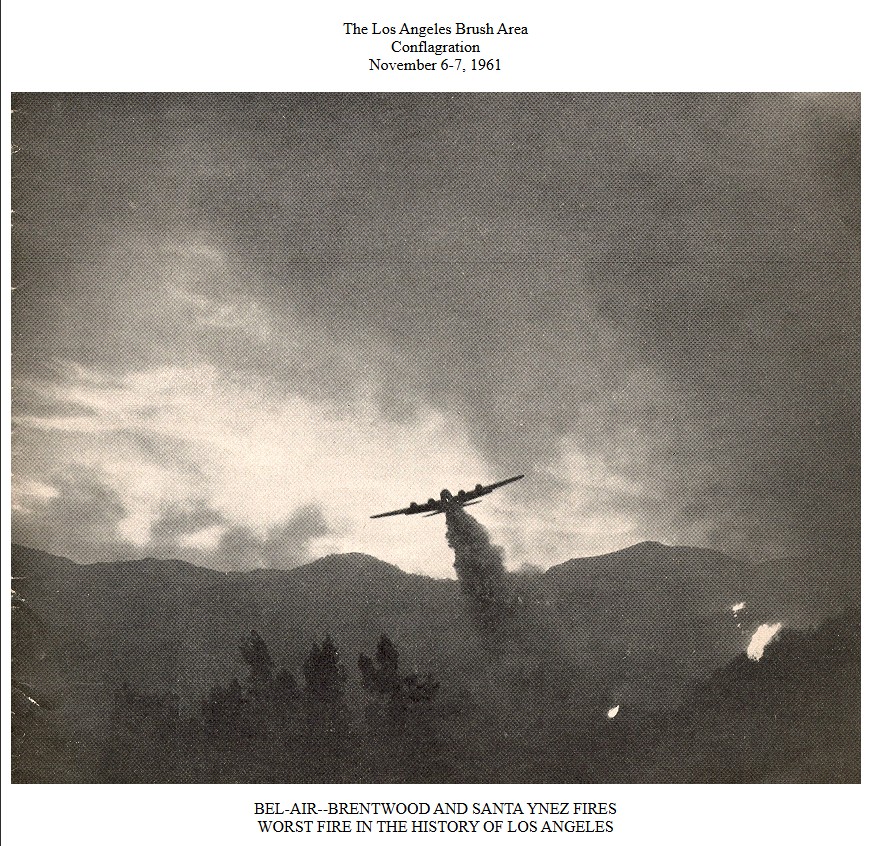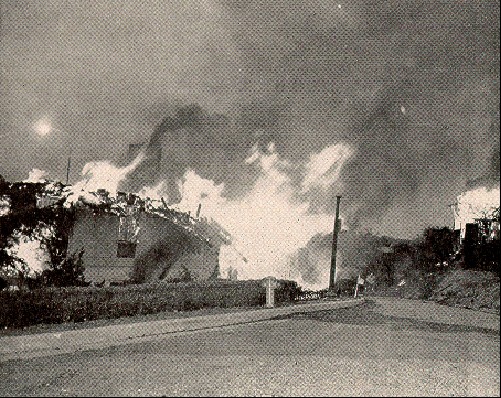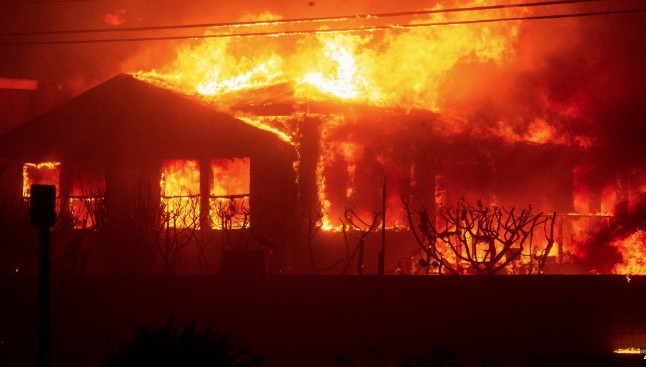(EDITOR’S NOTE: The Fire Department warned that a Palisades and Eaton Fires could happen more than 60 years ago. This story was taken from the Los Angeles Fire Department Historical Archive. To read the entire report, click here.. Most interesting to this editor the winds were reported at 50 mph during this fire. A neighbor on Via de la Paz had a weather station and his wind meter read 50 mph on January 7-before his home burned that evening.)
BRUSH FIRE RECOMMENDATIONS:
In seeking to prevent the occurrence of structural conflagrations in the brush-covered areas of the city, the fire department has consistently advocated measures designed to reduce the degree of hazard presently existing in these sections. Generally, the proposals contained herein were not made in the aftermath of the Bel Air-Brentwood Fire, but have been proffered repeatedly by the department as logical and practical means of relieving perilous conflagration-breeding conditions.
- Immediate adoption of ordinances, which are in process at the present time, which will provide for a Mountain Fire District, as outlined, and fire protection requirements with regards to buildings.
- That combustible roofs be prohibited on all new construction and on all repairs, alterations, or replacements of roofs on existing buildings within the City of Los Angeles, but specifically in the Mountain Fire District.
- The adoption of ordinances which will require adequate street width, non-excessive grades, turning radii, and adequate turning areas at the end of dead-end streets, plus proper parking regulations and the elimination of dead-end streets where life safety may be a factor.
- Proper numbering of dwellings, which would eliminate the numbering of a dwelling being on one street and the access being on another street.
- Proper establishment and maintenance of adequate street signs.
- Adequate control measures for brush clearance away from buildings and along highways and streets; such a control program to be done by City clearing crews, when necessary, and the expense to be charged on the tax bill.
- Restriction of new building activity; whether on dedicated streets, subdivisions, private streets, or metes and bounds, if the streets are of inadequate width, if turn-around areas are not furnished, or if adequate fire hydrants and water supply are not provided.
- Improvement of existing roadways that are of inadequate width, or do not have adequate hydrant distribution, whether they be dedicated streets, subdivisions, private streets, or metes and bounds.
- Installation of all power lines underground, within the Mountain District.
- The provision of more and wider fire breaks–either by sterilization, fire retardant planting, or bulldozer clearance.
- That engineering studies be made and that there be provided at least two streets or roads, running parallel to Mulholland and Sunset Boulevards, between Laurel Canyon and Topanga Canyon Boulevards. And further, that north and south through streets or roads be generally provided on each ridge and in each canyon, between Sunset and Ventura Boulevards, in the area bounded by Laurel Canyon, Topanga Canyon, Sunset, and Ventura Boulevards.
- That the water supply in the mountainous area be vastly strengthened.
- That full support be given to the Fire Department’s proposals, recommended by the Mayor’s Hill Brush Committee, which in many instances, parallels the foregoing recommendations.
- That full consideration be given to strengthening the Fire Department’s facilities, equipment, and manpower. This would include:
- A. Expansion of communications facilities, by providing more adequate radio equipment, capable of operation on three or more frequency channels.
- B. Increase in the number of reserve fire apparatus, hose, and equipment to be readily available for immediate use by off-duty personnel.
- C. Increase in the number of reserve vehicles for immediate use by off-duty personnel.
- D. Increase in the number of reserve vehicles for immediate use by off-duty Chief Officers.
- E. Additional hose for existing companies.
- F. Additional men to adequately man existing companies.
- G. Ten (10) additional 400-gallon tank vehicles and sixty (60) men (two men on duty full time for each vehicle).
- H. One additional helicopter (to strengthen reconnaissance, patrol, and fire fighting operations and to insure that at least one Fire Department manned and equipped helicopter will always be available).
CONCLUSIONS
As the great conflagration swept through the Bel Air and Brentwood residential sections leaving a wake of stark chimneys standing like mourning sentinels over the smoldering debris of once beautiful homes, the cost of continued toleration of severe conflagration-breeding conditions became glaringly apparent. Now armed with the vision of the horrible destructiveness of such a fire, the citizens of this progressive city may demand the necessary changes to be made that will assure the inhabitants of these brush-covered areas a reasonable degree of safety from repetitions of similar disasters.
The fire department has been intensely sensitive to the mounting danger during recent years. Witnessing the constantly increasing invasion of the canyons and ridges by home builders, fire officials recognized that a unique hazard was being imposed in these regions and was becoming more acute with the passage of time. Thirty years ago, firemen battled watershed fires on these lands under many of the trying conditions that are faced today. The frequent high winds, periods of low humidities, and the vast quantities of dry vegetation were present then as they are now. The one significant change is in the amount of structural development that has taken place during the past three decades.
Brush fires occur in this city every year with almost predictable regularity. As long as masses of highly susceptible vegetation cover the landscape and the climatic cycles produce dry, windy periods, firemen will be called upon to suppress watershed fires. Whether these will again affect populated sections depends primarily on the actions which are now taken to remove conflagration-breeding hazards.
Relatively few structures were lost in brush fires that occurred in the distant past for the reason that people did not then live in these regions to any appreciable extent. Today, thousands of homes are surrounded by vast tracts of natural vegetation. A potential fire condition, neither wholly watershed nor structural in scope, but with the worst features of both, lies in wait to sally forth to cut a flaming swath through brush and homes.
Little corrective legislation has been promulgated to deal with the growth of this singular and dangerous condition. Persistent efforts have been made by the fire department to secure ordinance changes that would effectively reduce the mushrooming conflagration hazard. To date, no legislation has been enacted to specifically counter this peculiar and dire peril in the mountainous portions of the city. The ravaged dwellings in Bel Air and Brentwood remain a depressing monument to this fact.
The people living in these regions will receive a maximum degree of security from fire only when reasonable and enforceable laws are produced to effectively regulate and control unsafe structural practices, brush clearance around buildings, water distribution, and accessibility within the mountain areas. Once a conflagration has begun, the best-trained fire fighters, most modern apparatus, and best tactical procedures can only struggle to restrict losses. To be realistic, it is the cause that must first be removed. No responsible fire authority can give assurance that a conflagration will not occur while, at the same time, terrible conflagration conditions are permitted to exist. If the Bel Air and Brentwood disasters are not to be repeated in the future, it is mandatory that conflagrations be attacked in the most intelligent manner—before they have a chance to begin.




Excellent Sue. This is what I have been talking about. And we all read it in the Times. Even us kids at the time and talked about it. Thank you for printing it.
home of the brave and the free
Pingback: All Rebuilding Targets the Victims of the Palisades/Eaton Fires | Circling The News